跨文化沟通与管理共57页
- 格式:ppt
- 大小:4.11 MB
- 文档页数:57
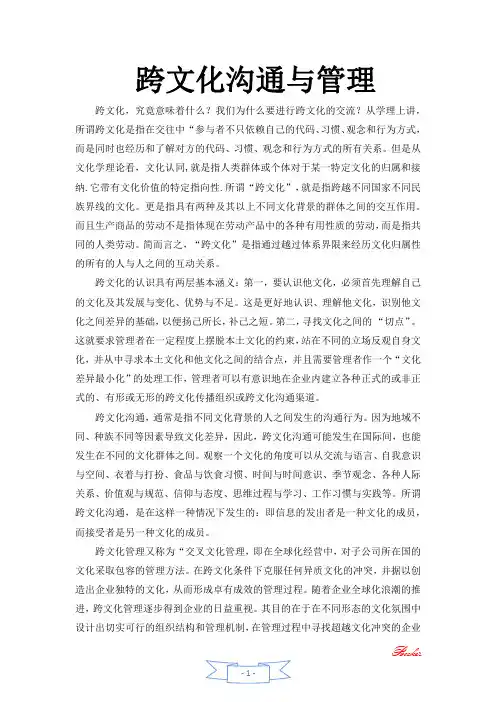
跨文化沟通与管理跨文化,究竟意味着什么?我们为什么要进行跨文化的交流?从学理上讲,所谓跨文化是指在交往中“参与者不只依赖自己的代码、习惯、观念和行为方式,而是同时也经历和了解对方的代码、习惯、观念和行为方式的所有关系。
但是从文化学理论看,文化认同,就是指人类群体或个体对于某一特定文化的归属和接纳.它带有文化价值的特定指向性.所谓“跨文化”,就是指跨越不同国家不同民族界线的文化。
更是指具有两种及其以上不同文化背景的群体之间的交互作用。
而且生产商品的劳动不是指体现在劳动产品中的各种有用性质的劳动,而是指共同的人类劳动。
简而言之,“跨文化”是指通过越过体系界限来经历文化归属性的所有的人与人之间的互动关系。
跨文化的认识具有两层基本涵义:第一,要认识他文化,必须首先理解自己的文化及其发展与变化、优势与不足。
这是更好地认识、理解他文化,识别他文化之间差异的基础,以便扬己所长,补己之短。
第二,寻找文化之间的“切点”。
这就要求管理者在一定程度上摆脱本土文化的约束,站在不同的立场反观自身文化,并从中寻求本土文化和他文化之间的结合点,并且需要管理者作一个“文化差异最小化”的处理工作,管理者可以有意识地在企业内建立各种正式的或非正式的、有形或无形的跨文化传播组织或跨文化沟通渠道。
跨文化沟通,通常是指不同文化背景的人之间发生的沟通行为。
因为地域不同、种族不同等因素导致文化差异,因此,跨文化沟通可能发生在国际间,也能发生在不同的文化群体之间。
观察一个文化的角度可以从交流与语言、自我意识与空间、衣着与打扮、食品与饮食习惯、时间与时间意识、季节观念、各种人际关系、价值观与规范、信仰与态度、思维过程与学习、工作习惯与实践等。
所谓跨文化沟通,是在这样一种情况下发生的:即信息的发出者是一种文化的成员,而接受者是另一种文化的成员。
跨文化管理又称为“交叉文化管理,即在全球化经营中,对子公司所在国的文化采取包容的管理方法。
在跨文化条件下克服任何异质文化的冲突,并据以创造出企业独特的文化,从而形成卓有成效的管理过程。


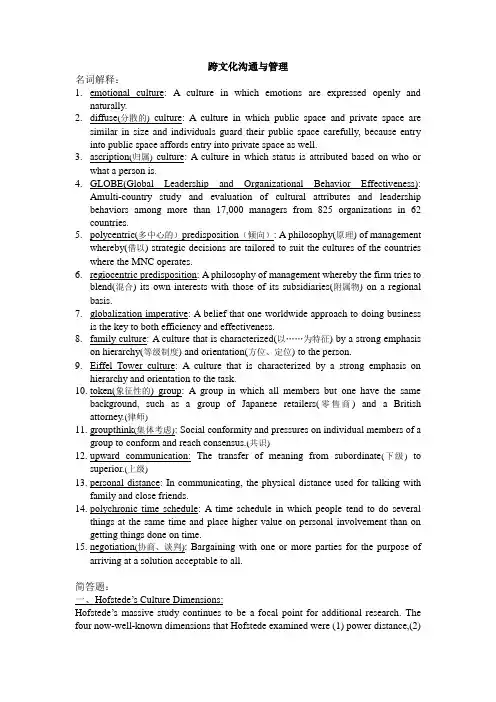
跨文化沟通与管理名词解释:1.emotional culture: A culture in which emotions are expressed openly andnaturally.2.diffuse(分散的)culture: A culture in which public space and private space aresimilar in size and individuals guard their public space carefully, because entry into public space affords entry into private space as well.3.ascription(归属)culture: A culture in which status is attributed based on who orwhat a person is.4.GLOBE(Global Leadership and Organizational Behavior Effectiveness):Amulti-country study and evaluation of cultural attributes and leadership behaviors among more than 17,000 managers from 825 organizations in 62 countries.5.polycentric(多中心的)predisposition(倾向): A philosophy(原理) of managementwhereby(借以) strategic decisions are tailored to suit the cultures of the countries where the MNC operates.6.regiocentric predisposition: A philosophy of management whereby the firm tries toblend(混合) its own interests with those of its subsidiaries(附属物) on a regional basis.7.globalization imperative: A belief that one worldwide approach to doing businessis the key to both efficiency and effectiveness.8.family culture: A culture that is characterized(以……为特征) by a strong emphasison hierarchy(等级制度) and orientation(方位、定位) to the person.9.Eiffel Tower culture: A culture that is characterized by a strong emphasis onhierarchy and orientation to the task.10.token(象征性的) group: A group in which all members but one have the samebackground, such as a group of Japanese retailers(零售商) and a British attorney.(律师)11.groupthink(集体考虑): Social conformity and pressures on individual members of agroup to conform and reach consensus.(共识)12.upward communication: The transfer of meaning from subordinate(下级)tosuperior.(上级)13.personal distance: In communicating, the physical distance used for talking withfamily and close friends.14.polychronic time schedule: A time schedule in which people tend to do severalthings at the same time and place higher value on personal involvement than on getting things done on time.15.negotiation(协商、谈判): Bargaining with one or more parties for the purpose ofarriving at a solution acceptable to all.简答题:一、Hofstede’s Culture Dimensions:Hofstede’s massive study continues to be a focal point for additional research. The four now-well-known dimensions that Hofstede examined were (1) power distance,(2)uncertainty avoidance, (3) individualism, and (4) masculinity.(1)Power distance is “the extant to which less powerful members of institutions andorganizations accept that power is distributed unequally.”(2)Uncertainty avoidance is “the extant to which people feel threatened byambiguous situations, and have created beliefs and institutions that try to avoid these.”(3)Individualism is the tendency of people to look after themselves and theirimmediate family only.”(4)Masculinity is defined by Hofstede as “ a situation in which the dominant valuesin society are success, money, and things.”二、Trompenaars’s Culture Dimensions:Trompenaars derived five relationship orientations that address the ways in which people deal with each other.(1)Universalism vs. Particularism: Universalism is the belief that ideas and practicscan be applied everywhere without modification. Particularism is the belief that circumstances dictate how ideas and practices should be applied and something cannot be done the same everywhere.(2)Individualism vs. Communitarianism: Individualism refers to people regardingthemselves as individuals, while communitarianism refers to people regarding themselves as part of a group.(3)Neutral vs. Emotional: A neutral culture is one in which emotions are held incheck. An emotional culture is one in which emotions are openly and naturally expressed.(4)Specific vs. Diffuse: A specific culture is one in which individuals have a largepublic space they readily let others enter and share and a small private space they guard closely and share with only close friends and associates. A diffuse culture is one in which public space and private space are similar in size and individuals guard their public space carefully, because enty into public space affords entry into private space as well.(5)Achievement vs. Ascription: An achievement culture is one in which people areaccorded status based on how well they perform their functions. An ascription culture is one in which status is attributed based on who or what a person is.三、文化的洋葱理论Schein divides organizational culture into three levels:1. Artifacts. These "artifacts" are at the surface, those aspects (such as dress) which can be easily discerned, but are hard to understand.2. Espoused V alues. Beneath artifacts are "espoused values" which are conscious strategies, goals and philosophies.3. Basic Assumptions and V alues. The core, or essence, of culture is represented by the basic underlying assumptions and values, which are difficult to discern beca use they exist at a largely unconscious level. Y et they provide the key to understanding why things happen in a particular way. These basic assumptions form around deeper dimensions of human existence such as the nature of humans, human relationships and activity, reality and truth.。


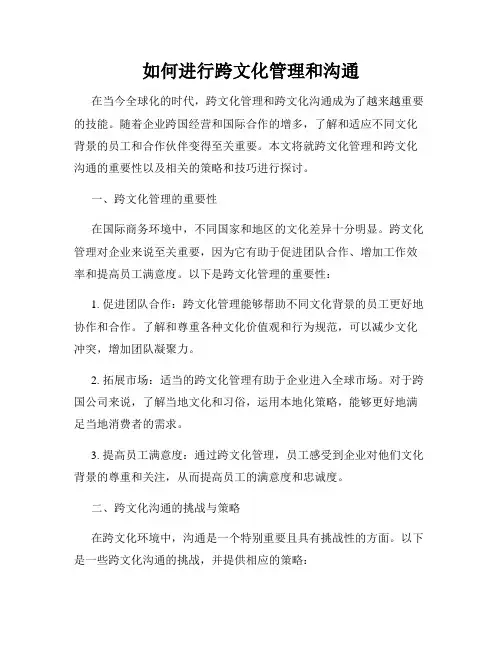
如何进行跨文化管理和沟通在当今全球化的时代,跨文化管理和跨文化沟通成为了越来越重要的技能。
随着企业跨国经营和国际合作的增多,了解和适应不同文化背景的员工和合作伙伴变得至关重要。
本文将就跨文化管理和跨文化沟通的重要性以及相关的策略和技巧进行探讨。
一、跨文化管理的重要性在国际商务环境中,不同国家和地区的文化差异十分明显。
跨文化管理对企业来说至关重要,因为它有助于促进团队合作、增加工作效率和提高员工满意度。
以下是跨文化管理的重要性:1. 促进团队合作:跨文化管理能够帮助不同文化背景的员工更好地协作和合作。
了解和尊重各种文化价值观和行为规范,可以减少文化冲突,增加团队凝聚力。
2. 拓展市场:适当的跨文化管理有助于企业进入全球市场。
对于跨国公司来说,了解当地文化和习俗,运用本地化策略,能够更好地满足当地消费者的需求。
3. 提高员工满意度:通过跨文化管理,员工感受到企业对他们文化背景的尊重和关注,从而提高员工的满意度和忠诚度。
二、跨文化沟通的挑战与策略在跨文化环境中,沟通是一个特别重要且具有挑战性的方面。
以下是一些跨文化沟通的挑战,并提供相应的策略:1. 语言障碍:不同的语言很可能成为跨文化沟通的障碍。
解决这个问题的策略包括雇佣熟悉当地语言的员工、利用翻译工具或雇佣专业翻译人员。
2. 非言语沟通:在不同的文化中,非言语沟通方式和姿势可能具有不同的意义。
了解和尊重这些文化差异,并注意自己的非言语沟通方式,能够帮助我们更好地与他人进行跨文化沟通。
3. 价值观和信仰的冲突:不同文化中的价值观和信仰可能存在冲突,造成沟通的障碍。
处理这个问题的方法是尊重他人的信仰和价值观,并避免争论和批评。
4. 文化敏感度培训:为员工提供跨文化敏感度培训,帮助他们了解不同文化的差异,认识到自己的文化偏见,并学习如何适应和尊重其他文化。
三、跨文化管理和沟通的实践技巧除了以上提到的策略,以下是一些实践技巧,有助于更好地进行跨文化管理和沟通:1. 尊重和敏感:尊重不同文化背景的人,避免对其进行贬低或冷落。

跨文化沟通与管理导语:在当今日益全球化的社会中,跨文化沟通与管理的重要性日益凸显。
了解和尊重不同文化之间的差异,有效地进行跨文化沟通,对于促进国家间、企业间的合作与交流具有重要作用。
本文将介绍跨文化沟通与管理的重要性,并列出实践步骤以帮助读者更好地应对跨文化交流。
一、跨文化沟通的重要性:1. 促进国际合作:跨文化沟通能够帮助不同国家间的人们消除隔阂,增进互相理解,从而促进国际合作与交流。
2. 提高商业竞争力:在全球市场中,了解并适应不同文化的商业习俗与沟通方式,能够帮助企业更好地开展国际业务,提高商业竞争力。
3. 丰富个人经验:通过跨文化交流,个人能够拓宽视野,增长见识,提升自我能力,丰富个人经验。
二、跨文化沟通的挑战:1. 语言障碍:不同语言的存在使得跨文化沟通变得困难,但是通过学习基本的沟通用语,可以缓解这一障碍。
2. 价值观差异:不同文化中的人们可能对同一问题有不同的价值观与看法,理解和尊重这种差异是跨文化沟通的重要一步。
3. 非语言沟通:文化背景的差异也会体现在非语言方面,如姿势、表情、目光等,需要注意相互之间的理解与尊重。
三、实践步骤:1. 学习目标文化:深入了解和学习目标文化的推崇价值观、行为准则以及习俗礼仪。
2. 语言学习:学习目标文化的语言,掌握一些常用的表达方式和基本的沟通技巧。
3. 适应当地风俗:在与目标文化的人们交流时,要尊重当地风俗习惯,避免引起不必要的矛盾与冲突。
4. 提升文化敏感度:了解和理解不同文化的差异,增加自己的文化敏感度,以更好地进行跨文化交流。
5. 建立信任关系:积极与目标文化中的人们建立互信关系,增进合作与信任,有助于提升跨文化沟通的效果。
6. 避免刻板印象:避免对目标文化的人们过于简单地概括和刻板印象,要尊重每个人的个体差异。
7. 尊重文化差异:积极学习与倾听目标文化中其他人的观点和见解,尊重他们的文化差异。
四、案例分析:以中国与美国的商业交流为案例,介绍如何有效进行跨文化沟通与管理。
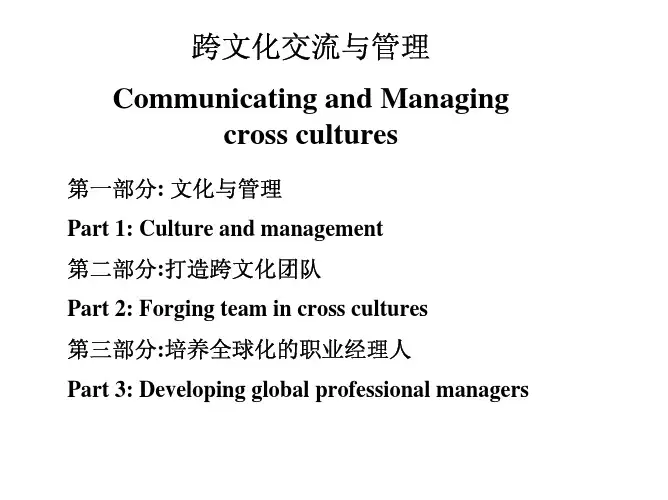

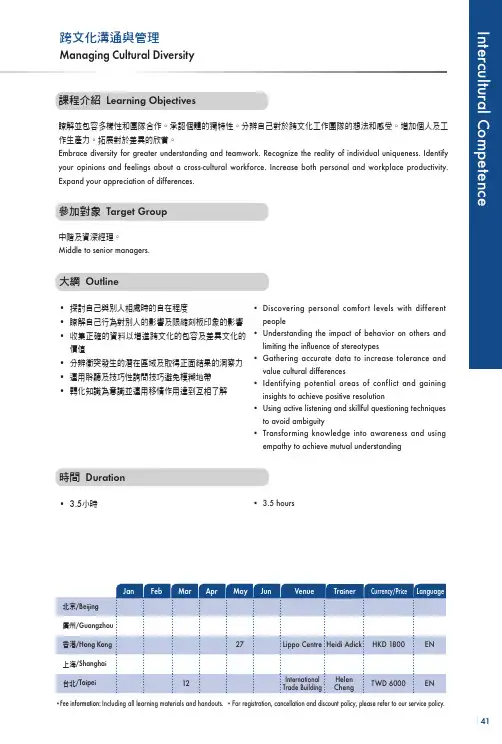
| 41跨文化溝通與管理Managing Cultural Diversity參加對象 Target Group中階及資深經理。
Middle to senior managers.•Fee information: Including all learning materials and handouts. • For registration, cancellation and discount policy, please refer to our service policy.大綱 Outline• 探討自己與別人相處時的自在程度• 瞭解自己行為對別人的影響及限縮刻板印象的影響• 收集正確的資料以增進跨文化的包容及差異文化的價值• 分辨衝突發生的潛在區域及取得正面結果的洞察力• 運用聆聽及技巧性詢問技巧避免模糊地帶• 轉化知識為意識並運用移情作用達到互相了解• D iscovering personal comfort levels with different people• U nderstanding the impact of behavior on others and limiting the influence of stereotypes• G athering accurate data to increase tolerance and value cultural differences• I dentifying potential areas of conflict and gaininginsights to achieve positive resolution• U sing active listening and skillful questioning techniquesto avoid ambiguity• T ransforming knowledge into awareness and usingempathy to achieve mutual understanding時間 Duration• 3.5小時• 3.5 hours課程介紹 Learning Objectives瞭解並包容多樣性和團隊合作。